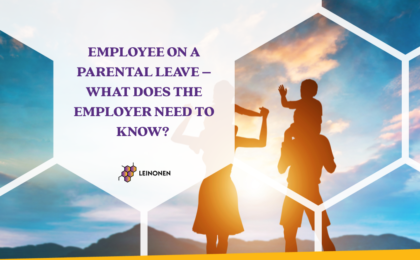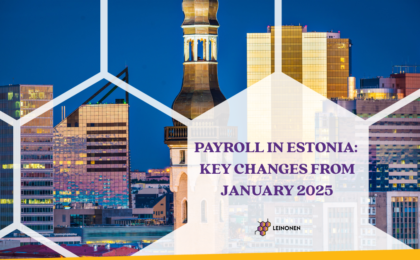Part II – Child leave
In connection with the amendments to the Employment Contracts Act taking effect on 01.04.2022, we have prepared a series of articles to explain the new regulation and the changes in it in more detail. The aim is to highlight the major principal changes, add practical tips and highlight the most important information both for employers as well as employees.
In the previous article, we took a closer look at the procedure for parental leave and parental benefits and clarified the new terms and definitions. This time, we will focus on child leave and the nuances related to it, and in the next, final article, we will explain the right of employees to ask for flexible working conditions, which was moved at the last moment from the Employment Contracts Act to the Gender Equality Act.
Child leave
From 1 April 2022, the system for taking child leave will change quite a lot. The right to child leave accrues to each parent separately and on a child-by-child basis. This means that each parent in an employment relationship receives 10 working days of child leave for each child under the age of 14, making a total of 20 days per child. The right to get child leave runs until the end of the calendar year in which the child reaches the age of 14. Child leave can be used by each parent for each child, but not more than 30 calendar days per calendar year. So, if a parent has, for example, 4 children, he or she will still not be able to use all 40 days in one calendar year.
It is, however, extremely important to remember that 10 working days of child leave are not per calendar year, but for the entire period of child care leave until the child reaches the age of 14. This amendment is a fundamental difference from the current arrangements, where child leave can be taken for either 3 or 6 working days per calendar year, depending on the age of the child and the number of children. The fact that both the mother and the father will henceforth be able to take child leave, and that the parents no longer have to decide who will take the leave, is also a different approach. Under the current arrangements, only one parent may take child leave for a child in any one calendar year. As of the new rules entering into force, the administration of child leave days and the leave accounting will be transferred from the employer to the Social Insurance Board, which will keep track of the leave days used on a parent-by-parent basis.
Child leave benefit
From 1st of April 2022, the child leave benefit will be paid in the same way as the parent benefit, i.e. depending on the parent’s previous income, and it will be 50% of the average income subject to social tax for the 12 months preceding the three calendar months from the first day of the child leave. The child leave benefit will therefore no longer be linked to the minimum wage.
Planning child leave
The days of child leave must continue to be indicated in the holiday schedule drawn up by the employer at the beginning of the year. If no child leave is indicated in the holiday schedule, the employee has the right to give the employer 14 calendar days’ notice of his/her wish to take child leave. An exception is, however, if an employee wants to take child leave not indicated in the holiday schedule for more than 15 calendar days at a time, in which case the minimum notice period is 30 calendar days.
On the practical side, it should be noted that in addition to the above, an application for holidays related to child leave must also be submitted to the Self-service of the Social Insurance Board, which in turn will automatically inform the employer of the employee’s wish to take leave. However, this process does not replace the procedure for taking child leave indicated in the employer’s holiday schedule or child leave not indicated therein, as the Social Insurance Board is not aware of the agreements already made between the employee and the employer. When requesting child leave, it is important to keep in mind the notice periods for requesting child leave set out in the employment relationship. You can always give more notice to the Social Insurance Board, but the maximum period here is two months before the start of the desired leave.
When the new procedure comes into force, the employer will retain the possibility to object to a request for child leave not indicated in the employee’s holiday schedule. If the Social Insurance Board forwards the employee’s application to the employer, but the employer has grounds for refusing to grant the leave, it will notify the Social Insurance Board within 5 working days, which will in turn forward this information to the employee. However, the employer’s grounds for refusal are limited, so you must always refer to the correct clause in the reasons.
Validity of the existing child leave procedure
With the entry into force of the new child leave procedure, the right to use child leave days under the previous procedure will not expire until 31.03.2022. This means that the number of days of child leave used before the entry into force of the new procedure will not change or reduce the entitlement to the current ten working days of child leave, and the new procedure for calculating child leave will start from 1.04.2022. Thus, those who are entitled to take, for example, 6 working days of child leave for the current year under the current regulation, can take them all until the end of March 2022. Of course, the employer must also be properly informed about the use of child leave. When the child leave system is so to speak restarted, i.e. as of 1.04.2022, the parent will be entitled to new ten days of child leave, but no longer per year, but for the entire period of child leave until the child reaches the age of 14.
In conclusion
Child leave was a rather under-used option for parents in practice, and a rather complex accounting obligation for the parties to an employment contract. The new child leave arrangements focus on automation and parental autonomy, which in turn will certainly give a greater incentive to make real use of these child leave days and ensure a more equal opportunity for parents to balance work and family life.
If you have any questions on this subject, please feel free to contact the Leinonen Tax and Legal Advice Department, where advisors will be happy to find an individual solution for each inquirer.
Author: Keiu Rebane
Position: Legal Advisor
Email: keiu.rebane@leinonen.ee
_block.png)




